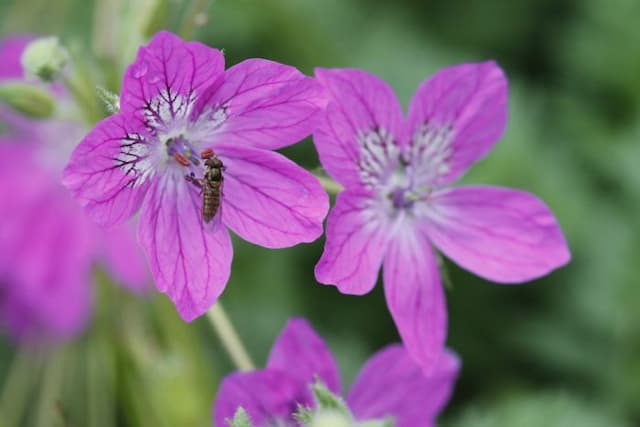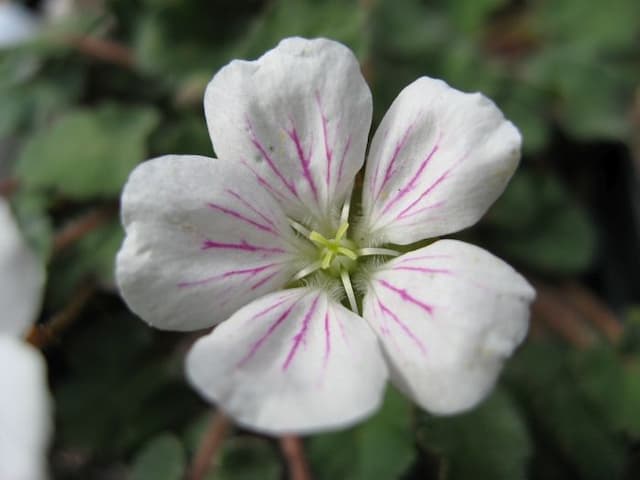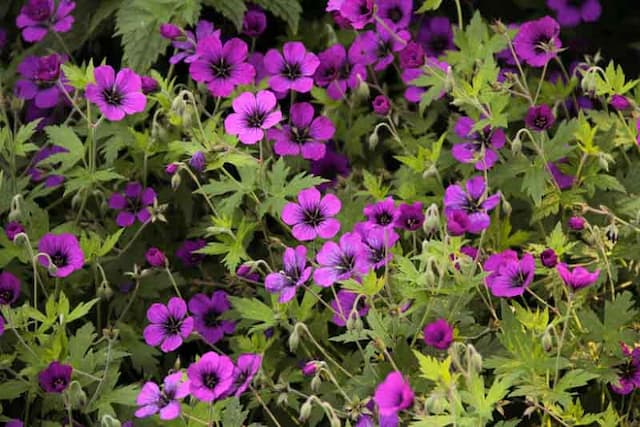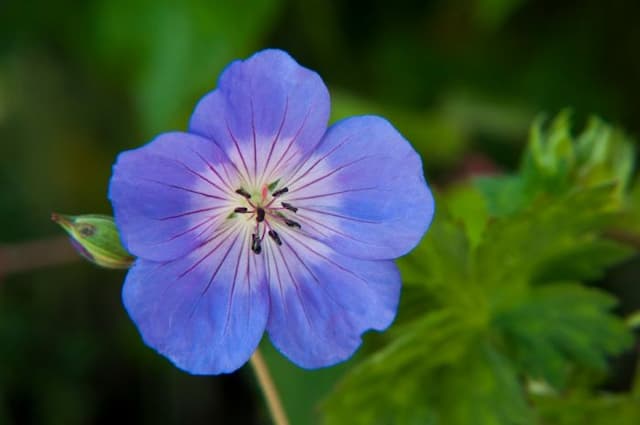Chinese cranesbill Geranium sinense

ABOUT
G. sinense is a low, spreading perennial, to 60cm tall, with deeply-veined leaves, to 10cm or more across, glossy, bright green above, paler below. Small, nodding flowers are held in loose clusters, the rounded, sharply-reflexed, petals are dark maroon-black, rose-pink at the base and are borne in mid to late summer
About this plant
 Names
NamesFamily
Geraniaceae.
Synonyms
Chinese Geranium, Ying Su, Xin Yi Geranium.
Common names
Geranium sinense.
 Characteristics
CharacteristicsLife cycle
Perennials
Foliage type
Deciduous
Color of leaves
Green
Flower color
Purple
Height
1-2 feet (30-60 cm)
Spread
1-2 feet (30-60 cm)
Plant type
Herb
Hardiness zones
4
Native area
China
Benefits
 General Benefits
General Benefits- Aesthetic Appeal: Geranium sinense adds vibrant color and visual interest to gardens and landscapes.
- Versatility: It can be used in borders, as ground cover, or in containers, offering flexibility in garden design.
- Attracts Pollinators: The flowers provide nectar for bees and other pollinating insects, which can help pollinate other plants in the garden.
- Easy Maintenance: This plant is known for being low-maintenance, requiring minimal care once established.
- Drought Tolerance: Geranium sinense has the ability to withstand periods of dryness, making it suitable for gardens in drier climates.
- Long Blooming Season: It has a lengthy flowering period which ensures lasting color in the garden throughout the growing season.
- Deer Resistance: The plant is generally resistant to deer, which can help prevent damage to gardens in areas with deer populations.
 Medical Properties
Medical Properties- Anti-inflammatory: Geranium sinense may help reduce inflammation in the body.
- Antioxidant: The plant may contain antioxidant properties that help protect the body from oxidative stress.
- Hemostatic: Geranium sinense is believed to help stop bleeding.
- Antibacterial: It may have antibacterial effects, which could help in fighting infections.
- Anti-ulcer: The plant might be used to help treat ulcers due to its potential anti-ulcer properties.
- Hepatoprotective: There is a possibility that Geranium sinense offers liver protection by preventing damage to liver cells.
- Antidiabetic: The plant may assist in managing diabetes by influencing blood sugar levels.
 Air-purifying Qualities
Air-purifying QualitiesThis plant is not specifically known for air purifying qualities.
 Other Uses
Other Uses- Geranium sinense leaves can be used in potpourri mixtures for their scent and as a natural insect-repelling agent.
- The flowers of Geranium sinense can be pressed and used in floral crafts, such as card making and scrapbooking, for their aesthetic appeal.
- The mucilaginous texture of crushed Geranium sinense leaves makes them usable as a natural thickening agent in certain homemade cosmetics.
- Dried Geranium sinense plant material can serve as a natural dye source for fabrics, imparting a range of colors depending on the mordant used.
- In companion planting, Geranium sinense can be used to attract beneficial insects that feed on common garden pests.
- The plant’s aromatic leaves can be included in herbal sachets to deter moths and other insects from closets and drawers.
- Geranium sinense can be planted in outdoor areas to provide ground cover and prevent soil erosion with its dense growth habit.
- The sturdy stems of Geranium sinense can be used in lightweight garden structures, such as plant supports or natural weaving projects.
- Excess plant parts of Geranium sinense can be composted to enrich the soil, as they decompose readily and add nutrients back into the ground.
- Certain cultures use the vibrant petals of Geranium sinense in ceremonies and to decorate festival venues due to their lively colors and patterns.
Interesting Facts
 Feng Shui
Feng ShuiThe plant Geranium is not used in Feng Shui practice.
 Zodiac Sign Compitability
Zodiac Sign CompitabilityThe plant Geranium is not used in astrology practice.
 Plant Symbolism
Plant Symbolism- Unexpected Meeting: In the language of flowers, the geranium can carry the meaning of an unexpected encounter or meeting.
- True Friendship: Geraniums are often associated with positive emotions and can symbolize a true and deep friendship between individuals.
- Folly or Stupidity: Though it might seem contrary to other meanings, sometimes geraniums can represent foolishness or silliness.
- Comfort: The geranium is also seen as a comforting plant, offering solace and a sense of familiarity and stability.
 Water
WaterHardy Geraniums should be watered deeply once a week, with adjustments made for particularly hot or dry conditions. Provide about 1 inch of water each week, which equates to around 0.623 gallons per square foot. During the growing season, ensure the soil is moist but not waterlogged to promote healthy growth. During the dormant period in the winter, reduce watering significantly, only moistening the soil when it is dry to the touch to prevent root rot.
 Light
LightHardy Geraniums thrive in full sun to partial shade. Place them in a spot that receives at least 4 to 6 hours of sunlight daily. Geraniums can tolerate a variety of lighting conditions but will produce more blooms in a brighter environment. Avoid intense midday sun in extremely hot climates, as it can scorch the leaves and stress the plant.
 Temperature
TemperatureHardy Geraniums enjoy a temperate climate and do best in temperatures ranging from 65°F to 75°F. They can survive slight frosts and temperatures as low as 30°F but should be protected from prolonged freezes. In regions with harsh winters, provide mulching or bring potted plants indoors to shelter them from extreme cold.
 Pruning
PruningPrune Hardy Geraniums to encourage bushier growth and more blooms. Prune back leggy stems in early spring and deadhead spent flowers regularly. After the first flush of blooms, cutting the plant back by half can promote a second bloom period. The best time to prune heavily is in late autumn or early spring.
 Cleaning
CleaningAs needed
 Soil
SoilHardy Geraniums thrive in a well-draining soil mix containing loam, compost, and sharp sand, favoring a slightly acidic to neutral pH between 5.8 and 7.2 for optimal growth.
 Repotting
RepottingHardy Geraniums should be repotted every 1-2 years to replenish nutrients and prevent the roots from becoming too compacted.
 Humidity & Misting
Humidity & MistingHardy Geraniums prefer moderate humidity levels but are fairly adaptable to various household humidity conditions as long as they are not in an excessively dry environment.
 Suitable locations
Suitable locationsIndoor
Place in bright, indirect light and ensure pot has drainage.
Outdoor
Choose a sunny spot with well-draining soil.
Hardiness zone
4-8 USDA
 Life cycle
Life cycleGeranium sinense, commonly known as Chinese Geranium, begins its life as a seed that germinates in spring when the soil temperature is warm and moisture is sufficient. The seedling stage follows, where the plant establishes its root system and first leaves (cotyledons) appear. As it enters the vegetative stage, the plant develops true leaves and stems, growing rapidly in favorable conditions of sunlight and nutrients. The flowering stage occurs next, with the plant producing distinctive flowers that can attract pollinators, ensuring cross-pollination. After successful pollination, the plant enters the fruiting stage where seeds develop within the beak-like fruit capsule. Finally, once the seeds mature, they are dispersed by wind or gravity, completing the cycle and potentially giving rise to new plants the following season.
 Propogation
PropogationPropogation time
Spring-Early Summer
Propogation: Geranium sinense, often known as Chinese Geranium, is best propagated through seed sowing or stem cuttings. The most popular method of propagation for Chinese Geranium is through stem cuttings. To do this, a healthy stem tip of about 4 to 5 inches long (10 to 12.7 centimeters) is selected. It is essential that the cutting has several leaf nodes. The lower leaves are removed, and the cut end can be dipped in a rooting hormone powder to encourage root growth. The stem cutting is then planted in a well-draining soil mix, ensuring that at least a couple of leaf nodes are buried as roots will develop from these nodes. The soil should be kept moist but not waterlogged, and the cuttings should be placed in a bright, indirect light condition until they have rooted, which typically occurs within a few weeks.









